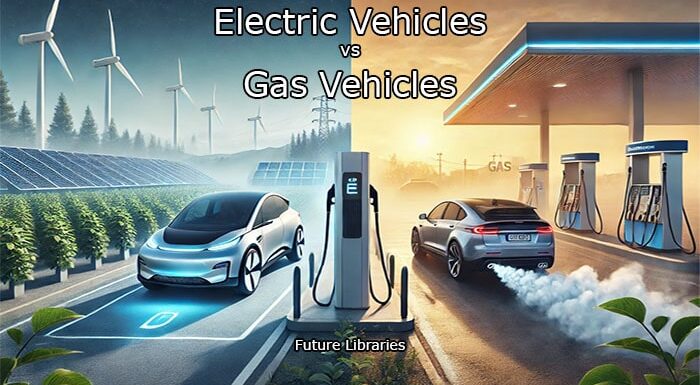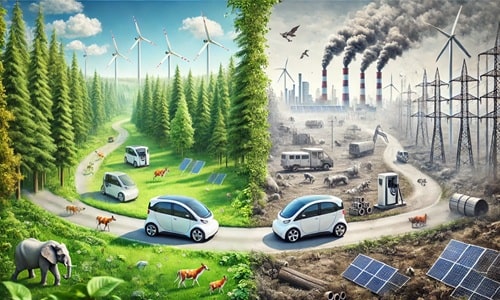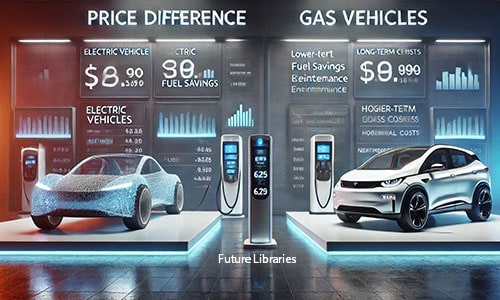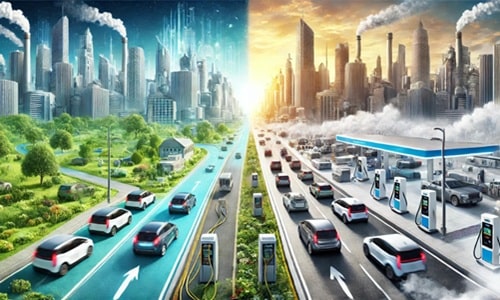
As the world moves toward more sustainable energy practices and the need to reduce carbon emissions grows, one of the most discussed topics in the transportation industry today is the comparison between electric vehicles (EVs) and gas-powered vehicles.
Both have their advantages and disadvantages, and the choice between the two depends on various factors including environmental impact, cost, convenience, and technological innovation.
In this article, we’ll dive deep into the differences between electric and gas vehicles, providing a detailed analysis to help consumers make informed decisions in an ever-evolving automotive landscape.
1. Environmental Impact: The Green Dilemma
One of the primary reasons why electric vehicles have gained so much traction in recent years is their significantly lower impact on the environment compared to that of gasoline vehicles.
Emissions
Gas-powered vehicles are notorious for their contribution to air pollution. The burning of gasoline in internal combustion engines (ICEs) releases carbon dioxide (CO2) into the atmosphere, a major driver of Earth’s climate change.
According to the Environmental Protection Agency (EPA), the average gasoline vehicle emits around 4.6 metric tons of CO2 per year, depending on its fuel efficiency and individual driving habits.
This CO2, along with other pollutants like nitrogen oxides (NOx) and particulate matter, contribute to smog and respiratory problems in urban areas.
Electric vehicles, on the other hand, produce zero tailpipe emissions. This means that while they don’t directly release pollutants like CO2 or NOx, their environmental impact depends on how the electricity they use is generated.
If an EV is charged using electricity from renewable sources like wind, solar, or hydroelectric power, it can be considered a truly green vehicle. However, if the electricity comes from coal or other non-renewable sources, then the emissions associated with charging an EV can be higher.
That said, even in regions where the grid relies on fossil fuels, EVs tend to have a smaller overall carbon footprint due to the higher efficiency of electric motors compared to that of internal combustion engines.
Battery Production and Recycling
One downside of electric vehicles is the environmental cost associated with battery production. The manufacturing of lithium-ion batteries, which power most EVs, requires mining of materials such as lithium, cobalt, and nickel.
This process can have environmental and social impacts, including habitat destruction, pollution, as well as unethical labor practices.
Furthermore, at the end of an EV’s life, battery recycling remains a challenge. Although the technology is improving, recycling processes for EV batteries are not yet as widespread or as efficient as they need to be moving forward.
However, the push toward sustainable mining practices, battery recycling innovation, and second-life battery applications is helping reduce some of these concerns.
2. Performance: Power, Efficiency, and Driving Experience
Electric vehicles and gasoline-powered vehicles offer very different driving experiences, and the performance factors of each can significantly impact a consumer’s choice.
Acceleration and Power Delivery
Electric vehicles are known for their instant torque and smooth acceleration. Unlike gas vehicles, which require time to rev up and reach peak power, EVs can accelerate quickly from a standstill. This is due to the nature of electric motors which deliver their power immediately when the accelerator is pressed.
For performance enthusiasts, this means that EVs can offer exhilarating acceleration even in everyday driving situations. High-end EVs like the Tesla Model S Plaid and the Lucid Air have become benchmarks for performance, rivaling traditional supercars in terms of speed and handling.
Gas-powered vehicles, by contrast, take longer to achieve their peak power performance. Internal combustion engines have to rev up to a certain RPM before they can deliver the desired power that the driver is needing or wanting.
For some driving enthusiasts, the sound and feel of a gasoline engine roaring to life is part of the driving experience, which EVs lack due to their silent motors.
Efficiency and Range
Electric vehicles are much more energy-efficient than gas vehicles. An electric motor can convert more than 85-90% of the energy from the battery into actual movement, while internal combustion engines can only convert about 20-30% of the energy from gasoline into usable power.
This makes EVs far more efficient at utilizing energy, which can lead to significant savings over time, especially as the price of electricity remains relatively stable compared to always fluctuating gas prices.
Range, however, has historically been a point of concern for electric vehicles. While gas vehicles can easily go 300-400 miles on a full tank, many earlier EV models had a range of only 100-150 miles. However, advancements in battery technology have dramatically improved the range of electric vehicles.
Models like the Tesla Model 3 Long Range and the Rivian R1T can now achieve over 300 miles on a single charge, which is on par with many gas-powered vehicles.
That said, the availability of fast-charging infrastructure remains an important consideration for long-distance travelers.
Gas vehicles typically enjoy the convenience of rapid refueling at a gas station, which takes just a few minutes. In contrast, EV charging times can range from 30 minutes to several hours, depending on the charger’s speed and the battery’s capacity.
However, home charging at night has become a convenient solution for many EV owners, allowing them to start each day with a full battery.
3. Cost Considerations: Initial Investment, Operating Costs, and Incentives
When comparing electric and gasoline vehicles, cost is often the first consideration for many vehicle buyers.
Purchase Price
Historically, electric vehicles have had a higher upfront cost due to the expensive lithium-ion batteries. However, as battery technology improves and economies of scale come into play, the cost of EVs has been steadily declining making their prices more comparable to that of gas powered vehicles.
Many popular electric vehicles, such as the Tesla Model 3 and Chevrolet Bolt, are now priced competitively with mid-range gasoline vehicles. Additionally, available federal and state tax incentives for electric vehicles can help offset some of the initial price.
Gasoline vehicles, while generally more affordable upfront than electric vehicles, can be more costly to maintain over time due to fuel expenses, maintenance and repairs.
Traditional engines have more moving parts, which means they are more prone to wear and tear. This can result in higher maintenance costs, including oil changes, brake repairs, and exhaust system issues.
Operating Costs
Electric vehicles generally have lower operating costs compared to gasoline vehicles. Electricity is cheaper than gasoline on a per-mile basis, and EVs have fewer moving parts, which translates to lower maintenance costs.
With no oil changes, fewer brake replacements (thanks to regenerative braking), and fewer parts that can wear out, EVs can save owners hundreds or even thousands of dollars in long-term maintenance over the life of the vehicle.
Gas vehicles, on the other hand, require regular fueling, and depending on your location and vehicle’s fuel efficiency, the cost of gasoline can be significant over time. In addition, regular maintenance like oil changes, tune-ups, and exhaust system repairs can add up.
4. Infrastructure and Convenience: Charging Stations vs. Gas Stations
When it comes to convenience, one of the most notable differences between EVs and gas-powered vehicles is the refueling process.
Charging Infrastructure
While gas stations are abundant, with more than 100,000 locations across the U.S., charging stations for electric vehicles are not as widespread. However, the number of charging stations has been steadily increasing, especially in urban areas and along major highways.
Tesla’s Supercharger network, along with other public charging networks such as Electrify America and ChargePoint, is expanding rapidly, making long-distance travel for EVs a lot more feasible.
Home charging is an attractive option for many EV owners, as they can plug in overnight and start the day with a full battery. Still, the need for access to a home charging setup can be a limiting factor for people who live in apartments or houses without dedicated parking spaces.
Gas stations, on the other hand, are ubiquitous and require only a few minutes to fill up, making refueling a quick and convenient process.
5. The Future of EVs and Gas Vehicles: What Lies Ahead?
The automotive industry is undergoing a massive transformation. Governments around the world are setting aggressive targets for reducing greenhouse gas emissions, and many different countries have already pledged to phase out gasoline and diesel vehicles over the coming decades.
This, combined with rapid advancements in battery technology, charging infrastructure, and energy sources, means that electric vehicles are set to become the dominant form of transportation in the not so distant future.
At the same time, gas vehicles will continue to be a reliable option for many drivers, especially in regions where infrastructure for EVs is still lacking, or where long driving ranges are a necessity.
However, with increasing fuel efficiency, hybrid models, and alternative fuels like hydrogen and biofuels, gas vehicles are also evolving in response to the environmental concerns about them.
Conclusion
In the debate between electric vehicles and gasoline vehicles, there is no one-size-fits-all answer. Electric vehicles are clearly the better choice for environmentally-conscious consumers who are looking to lower their carbon footprint and reduce operating costs over time.
They offer quiet, efficient, and high-performance driving experiences that are becoming more practical with each new model and generation.
On the other hand, gas vehicles still offer certain advantages, such as a wider range of refueling infrastructures and a more established, diverse market.
For consumers who rely heavily on long trips or need quick refueling, gas-powered vehicles may remain the more practical choice for the near future.
Ultimately, as the transition to electric vehicles accelerates and as more advancements are made in charging infrastructure and battery technology, we can expect the gap between EVs and gas vehicles to continue narrowing, making the decision to go electric even easier for many more drivers.
Whether you are driven by performance, environmental concerns, or cost savings, electric vehicles are undoubtedly a significant part of the future of transportation and gas powered vehicle may soon be a thing of the past!








Comments are closed, but trackbacks and pingbacks are open.